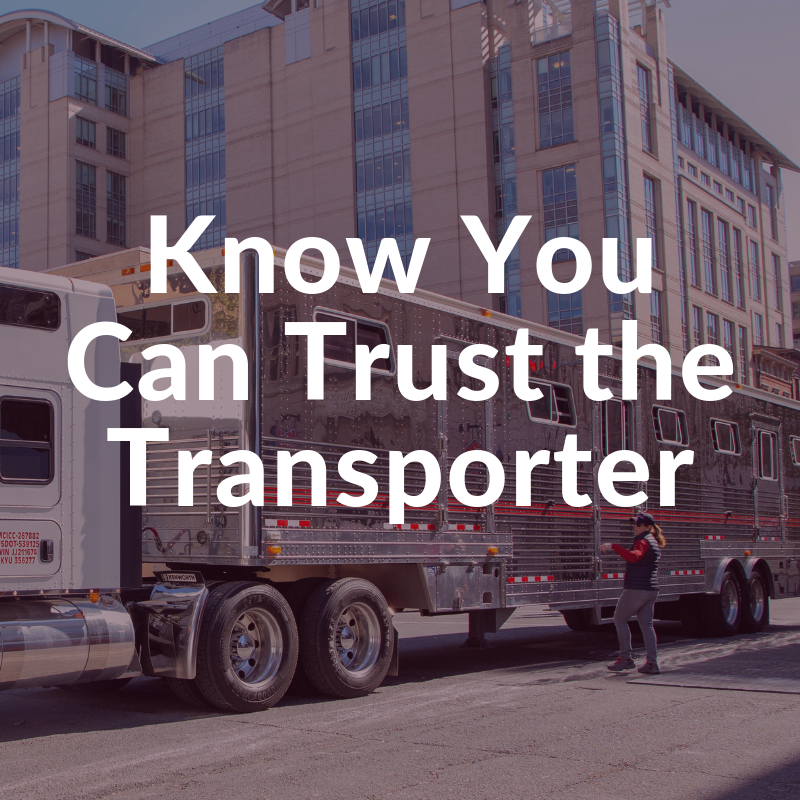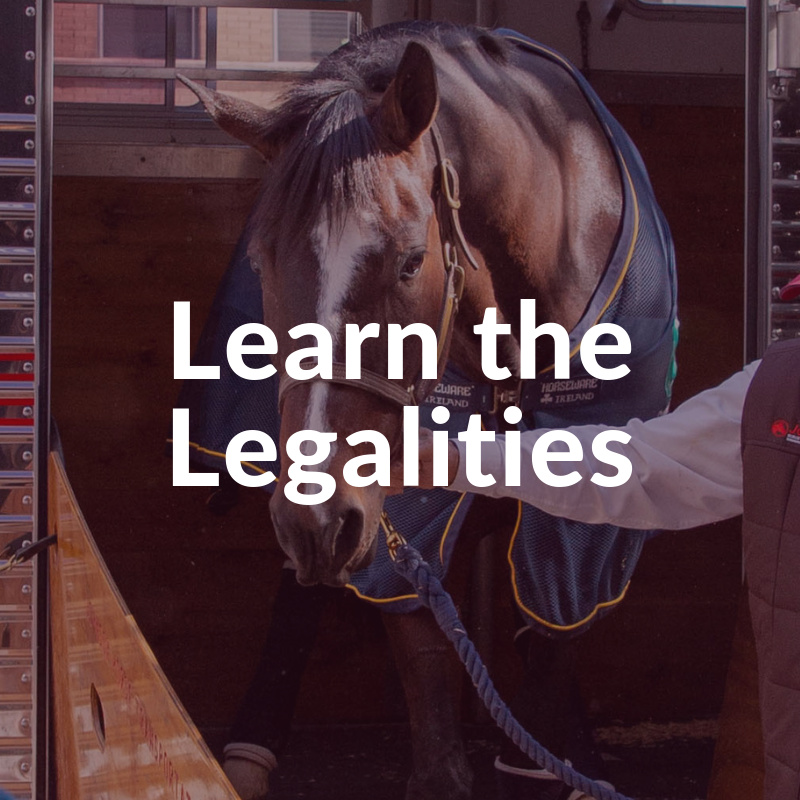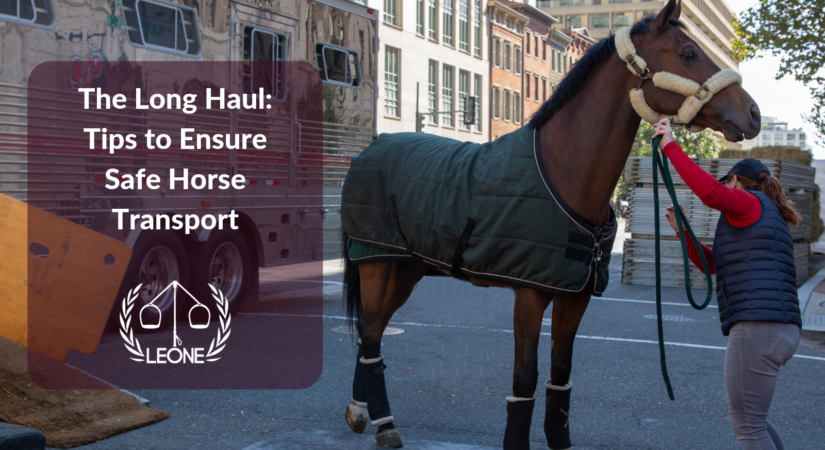As horse people, we have likely all heard the commercial shipping horror stories: a trailer that flipped on the highway, the horse that arrives at its destination with severe shipping fever, the horse left to die on the side of the road. Any time a horse or human enters a vehicle, particularly for a long duration of time, there is an inherent risk. Fortunately, safe transports outweigh the horror stories, and there are numerous steps and precautions you can take before shipping to ensure a positive outcome for both you and your horse.
 Ship a Healthy Horse, Maintain a Healthy Horse
Ship a Healthy Horse, Maintain a Healthy Horse
First, minimize risk by sending a healthy horse when feasible, and take the basic measures to promote the horse’s safety and welfare prior to transport. Ensure that the horse is up to date on immunizations and has received a proper veterinarian examination prior to departure. If you are shipping your horse across states, this is not only a helpful precaution, but also likely a requirement. State entry requirements vary and knowledge of what veterinary documentation may be needed is essential prior to the horse’s departure.
For long hauls, discuss the type of feed and the feeding and watering schedules with the driver and any attendants prior to departure. Know in advance whether a layover is planned, and if so, the location and estimated duration. Find out if someone will remain with the horses during transport and during any layovers, and if not, whether the horses will be watched electronically. Traveling a long distance can be a stressful experience for a horse, and problems can arise quickly, so it is important to know that their health and well-being will be monitored closely throughout the trip.
In some instances, number of horses being transported and their positioning on the truck can raise concerns, and it is smart to also be aware of this in advance. In one reported legal decision, an individual sought damages when his stallion was attacked by the one placed next to him when it broke loose from the restraints – perhaps a scenario that could have been avoided had different precautions been taken regarding the two stallions being positioned next to one another.
Know You Can Trust the Transporter
Once you have taken the necessary health measures on your end and discussed travel arrangements with the transporter or transporting company, your horse’s well-being is ultimately left largely in their hands – which is why it is so crucial to take great care in selecting the right transporter from the beginning.
While cost is a common concern, beware that a lower expenditure may correlate with higher risk. Determine whether the transporter is a licensed carrier in good standing. With the ease of access to the internet, exploring the reputation and licensure of a carrier may provide relevant information when deciding upon which carrier to entrust with your horse’s safe transportation. Explore or ask whether the driver has a commercial driver’s license (class A or B) and find out what amount of commercial liability insurance the transportation company may carry.
Learn the Legalities
In addition to determining whether the transporter has the proper licensing and insurance, it can be useful to understand a few shipping and liability legalities in advance, should a problem arise down the road.
 In the event that an accident and injuries culminate in litigation, many circuit courts have held that federal law preempts any state law claims for negligence, fraud, or breach of contract actions when a horse is being transported across state lines. The Carmack Amendment to the Interstate Commerce Act, 49 USCS Section 11707 et seq., enacted in 1906, enables a licensed carrier transporting a horse across state lines to limit liability for the injury or loss to a horse by showing compliance with a four-part test:
In the event that an accident and injuries culminate in litigation, many circuit courts have held that federal law preempts any state law claims for negligence, fraud, or breach of contract actions when a horse is being transported across state lines. The Carmack Amendment to the Interstate Commerce Act, 49 USCS Section 11707 et seq., enacted in 1906, enables a licensed carrier transporting a horse across state lines to limit liability for the injury or loss to a horse by showing compliance with a four-part test:
- by having the carrier provide to the shipper, upon request, a copy of the rate, classification, rules and practices upon which any rate applicable to the shipment or agreed to between shipper and carrier is based,
- by obtaining the shipper’s agreement as to choice of liability,
- by giving the shipper reasonable opportunity to choose between two or more levels of liability,
- and by issuing a receipt or bill of lading prior to transport that reflects the agreement.
One of the most important of these legalities to understand is the aforementioned “bill of lading,” the detailed documentation of the animals or goods being shipped, given by the transporter to the individual requesting to have the horse or items shipped. The typical bill of lading contains a nominal estimated value of the horse being shipped and must be signed by the individual shipping the horse. To minimize the potential for conflict, the shipping company or transporter should make certain that the bill of lading is conspicuous on any paperwork given to the individual wishing to have their horse transported, and it should provide space for the horse owner or handler to write his or her own estimate as to the value of the horse.
Of particular interest to an owner transporting a horse across state lines is the provision in the bill of lading requiring that the shipper be given opportunity to choose between two or more levels of liability. Accepting a low declared value usually equates with lower transport costs, and declaring a value in excess of the nominal value will result in an increased shipping charge. Depending upon the value of the horse, a shipper’s risk tolerance, and private insurance coverage options, an informed decision can be made with regard to declaring a value in excess of the nominal value identified in a carrier’s bill of lading.
Finally, in regard to the bill of lading, it is important to know that no matter who signs the document on behalf of the horse being shipped, it is still binding as long as they are deemed to be an agent of the owner. Today, it is common practice for the groom or the trainer to be the one present when transportation arrives, and they are therefore the individuals handed the bill of lading for signature. Often that person will sign the form without examining the provisions or even reading the document. In the event that a tragic accident occurs, the owner’s claim that he did not know or authorize a groom or trainer to sign the bill of lading declaring the horse of nominal value will not overcome the finding of agency binding him to the terms of the document.
Factors that may be deemed relevant in determining whether the person signing the bill of lading had the requisite authority to bind the owner include the nature of the relationship of the persons involved and the individual characteristics of the shipper. For example, in Kentucky, an owner was deemed bound by his horse’s declared value in the bill of lading after a groom of his trainer signed the document. Relevant to the court’s decision was the fact that the owner was a seasoned horseman and attorney with years of experience shipping numerous horses that belonged to him. Jackson v Brook Ledge, 991 F. Supp. 640 (E.D. KY 1997). Generally, trainers are deemed to have the authority to perform acts related to transport of an owner’s horse that will bind the owner.
In the event that your horse is injured during transit, consulting with an attorney immediately thereafter may prove prudent to assess whether a lawsuit is feasible and what the appropriate jurisdiction and any controlling time limitations that must be strictly complied with may be.
While these steps and precautions may sound daunting to some, putting in the extra effort prior to shipping a horse can go a long way in ensuring that the horse is safe, well-cared for and with you for the long haul.
– By Jessica Choper, Esq., Leone Equestrian Law
For questions regarding equine transportation laws and legal matters, contact Leone Equestrian Law at info@equestriancounsel.com or 201-444-6444. [/fusion_text]

